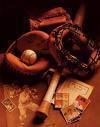Baseball Math Lesson Plans - Batter Up!
The game of baseball provides many opportunities for mathematical learning.
By Greg Harrison

Baseball and math go hand-in-hand. If you had to pick one game that is loaded with mathematical data, it would be baseball. Statistics is the main strand of math found in baseball. Batting averages, earned run averages, on-base percentage, slugging percentage......my goodness! Statistics are everywhere in baseball. In fact, I believe that my love of math (and my good "head for numbers"), comes from the many hours I spent as a young boy looking over the box scores in each day's newspaper, and at all of the statistics on the back of baseball cards.
One terrific way to tie baseball and math together is to have a "Bulletin Board Baseball" game up in your room during the beginning of the baseball season. In this game, students solve math problems on a baseball diamond pinned to a bulletin board. Each base contains up to ten math problems inside an envelope. A student would solve one problem, and with a paper baseball with their name on it, would advance to the next base, until they scored a run by getting to home. You can keep a running total of runs scored for each student on the board. Students can work individually, or team up in pairs. The great thing about this activity is that it runs itself. Quite often, when students have finished their work, or are having inside choice time, they head over to the bulletin board and try to go around the diamond as many times as they can.
Why not include some real life baseball-math problems in the envelope? There are all sorts of possibilities. Here are a few ideas:
Batting average: Divide the number of base hits by the total number of at bats. Example: If Albert Pujols had 400 at bats and has 157 hits, his batting average would be .393. (157 hits/400 at bats = .393)
Earned Run Average: Multiply the total number of earned runs by nine, and divide the results by the total innings pitched. Example: Josh Beckett allows 3 earned runs in 8 innings for an ERA of 3.38. (3 runs x 9 innings=27, 27/8 innings = 3.38)
Won-Loss Percentage: Divide the number of games won by the total number of games played. Example: If the Mariners win 20 out of their first 33 games, they would have a .606 winning percentage, meaning they won about 61 percent of their games. (20 wins/33 games = .606)
Slugging percentage: Divide the total number of bases of all base hits by the total number of times at bat. Example: Derek Jeter hit two home runs (8 total bases), a double (2 bases) and single (1 base) in his first 13 at bats for an .846 slugging percentage. (11 bases/13 at bats = .846)
On-base percentage: Divide the total number of hits plus walks plus hits by pitch by the at bats plus walks plus hit by pitch plus sacrifice flies. Example: In David Ortiz's 334 at bats, he has 97 hits, 24 walks, he’s been hit by 4 pitches and has 7 sacrifice flies, his on-base percentage would be .339. (97 hits + 24 walks + 4 hits by pitches = 125; 334 at bats + 24 walks + 4 hit by pitches + 7 sacrifice flies = 369; 125/369 = .339)
Here are some other lesson plans that provide mathematical learning with a baseball theme.
Baseball Math Lesson Plans:
Students of all ages can enjoy playing the game described in this wonderful lesson. The desks are cleared out to form a "baseball field" in the room, and two teams try to score runs by correctly answering math questions. The concept in this game is very similar to the bulletin board activity I described above.
Math at Wrigley Field and Beyond
As we all know, a lot of the math involved in baseball is represented by the huge amounts of money we spend to get to, and go to, a baseball game! Students take a virtual vacation to the famous Wrigley Field in Chicago, and to three other Major League baseball parks. They calculate the distance travelled to each park, and the expenses involved in going to the games.
Students use baseball cards to help them practice the skills necessary to calculate batting averages. They demonstrate how a player's batting averages are obtained. Students are often amazed when I tell them that a player who only gets 3 hits in every 10 times to the plate (or you can say that they fail to get a hit 7 out of every 10 times up) is considered to be an excellent hitter because he has a .300 batting average. That's how hard hitting a baseball is!
I must admit, these incredible lessons about baseball have more geography, history, and language arts ideas than math activities in them, but I just had to include this for you because it's such a well-designed unit for upper elementary to junior high school students. Even if you utilize just a few of the many teaching opportunities you'll find in these fabulous lessons, your students will greatly benefit.